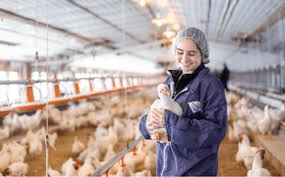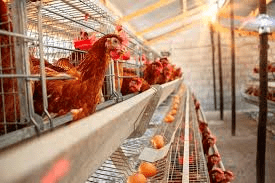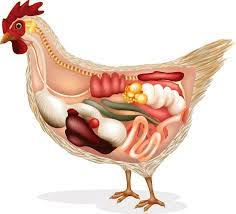Good poultry health management is an important component of poultry production. Infectious disease causing agents will spread through a flock very quickly because of the high stocking densities of commercially housed poultry.
For poultry health management to be effective a primary aim must be to prevent the onset of disease or parasites, to recognise at an early stage the presence of disease or parasites, and to treat all flocks that are diseased or infested with parasites as soon as possible and before they develop into a serious condition or spread to other flocks.
To be able to do this it is necessary to know how to recognise that the birds are diseased, the action required for preventing or minimising disease and how to monitor for signs that the prevention program is working.
Ten Commandments of Poultry Health

- To maintain good poultry health, you should always be at alert for sign of diseases.
- Always get an accurate diagnosis immediately by calling on the veterinarian.
- Always be careful with visitors or strangers who might transfer disease organisms to your birds.
- Always keep confined chicks in clean disinfected and dried quarters.
- Always follow a rigid vaccination program.
- Always ensure that birds are supplied with well-balanced rations.
- Provide good ventilation for birds.
- Get rid of dead birds either by burning or burying deep in the ground.
- Remember to clean and disinfect thoroughly all quarters, where diseases had existed before bringing healthy birds.
- Avoid spillage of water on the litter and always to ensure to remove the used litter fortnightly.
Read Also: Poultry Records Keeping Books, Types and Benefits
Poultry Chickens Health Problems
Below are some of the diseases found among poultry chickens which hinders or prevents maintaing a good poultry health thereby leading to a great loss to the poultry farmer:
Coccidiosis: This disease is caused by a parasite called coccidia. The disease is common in both chicks / chickens and turkeys, as well as other animals. Chickens should have a coccidiostat such as amprolium in the feed. Birds with this disease appear listless, pale and chilled, and may also show bloody droppings.
Mareks Disease: This disease affects the nerves and visceral organs of the chicken, resulting in paralysis and tumors of the internal organs. There is no treatment; however, vaccination at the hatchery is highly recommended.
Leg Problems: Twisted joints, swelled or bowed legs and curled toes will occur to a certain extent in most flocks of broilers and turkeys. However, management, nutrition, litter and disease can contribute to a higher incidence of the problem.
To minimize the problem, follow feeding, floor space and equipment recommendations. Also keep the litter in good condition by removing wet spots and maintaining proper ventilation.
Breast Blisters: This condition is caused by constant contact with litter or equipment. The condition or incidence increases with wet litter, overcrowding and leg problems. The condition is most common with heavy broiler chickens or turkeys.
Cannibalism: This is a habit that develops in the form of feather picking, “pickouts” of the vent or picking at other areas on the bird. This bad habit can start at any age if conditions are right.
The most common causes of cannibalism are overcrowding, too high a temperature, poor ventilation and high light intensity. Remove any affected birds, maintain adequate feed intake and correct any of the above management problems. Beak trimming (debeaking) could be considered to help correct the problem.
Lice and Mites: These parasites can steal profits without being noticed. They can cause severe decreases in egg production, egg size and growth rate. Lice can easily be detected around the vent or base of the feathers.
Mites will appear as a sprinkling of grey pepper in the vent area. Both lice and mites can be controlled by insecticides. Three or 4 treatments at 10 day intervals may be needed.
Internal Parasites: Worms commonly infest the intestinal tract of birds. The most common are the large round worms, cecal worms and tape worms. Good sanitation between flocks and control of wild birds and insects will help prevent infestation of worms.
Read Also: Nutritional Deficiency and How it affects Poultry Birds
Vaccination
In poultry health, disease prevention may be practiced by isolation of different age groups and species of birds. Thoroughly clean up between flocks. Also, purchase healthy birds, vaccinate properly, dispose of dead birds, maintain a comfortable environment and control traffic between flocks of birds.
These steps will generally control most poultry diseases and maintain poultry health. There will be times when a vaccination program becomes necessary because of past history of the farm or geographic area. A suggested vaccination schedule for some of the more common poultry diseases is listed below:
| Disease | First Vaccination | Second Vaccination | Third Vaccination |
|---|---|---|---|
| Marek’s Disease | One day of age at hatchery | ||
| Newcastle-Bronchitis | 2 weeks | 6 weeks | 16 weeks |
| Fowl Pox | 12 weeks | ||
| Epidemic Tremor | 14 weeks |
Work with your local vet to develop a good poultry health program for your particular flock.
Causes of Poultry Infectious Diseases

Organisms and microorganisms that have the potential to cause harm, such as disease in animals, are called pathogens or disease vectors.
There are many different types of pathogens that may be transferred from one bird to another or from one flock to another by many different means. These pathogen types include:
- Viruses
- Bacteria
- Fungi
- Protozoa
- Internal parasites
- External parasites
(1) Viruses
Viruses are the smallest pathogens and can only be seen through an electron microscope. Viruses consist of an outer layer/s surrounding special protein material similar to the genetic material of the cells they invade.
They can multiply and do harm only when inside the animal cell and if they invade and damage enough cells, the animal can show signs of that infection.
Antibiotics and other medications as a rule do not affect viruses and, as a consequence, there are very few medications that can treat diseases caused by viruses, although there are times when a drug may be used to control secondary infections.
To maintain poultry health, the best way to manage diseases caused by viruses is by quarantine and good hygiene to lower the challenge, and vaccination to maximise the birds’ immunity to future challenges.
Some have the ability to survive for very long periods of time in the bird dander and feather debris, litter and manure, insects and rodents.
Read Also: How to Control and Prevent Disease Outbreak on your Poultry Farms
(2) Bacteria
Bacteria are single cell organisms with a nucleus and multiply by simple fission, which means that one divides into two, and some can do this very quickly inside the host or in a suitable environment. Some are very fragile and do not survive long outside of the host while others may survive for long periods even in a harsh environment.
Many have the ability to turn into spores by forming a very tough wall that protects them from most of the materials used to kill them. These types of bacteria are much more susceptible to these compounds when not in the spore form.
Bacteria may be described as being gram positive or gram negative. This characteristic is to do with differences in their cell walls that affects their staining for viewing under the microscope. Whether they are one or the other also influences their response to certain chemicals, including disinfectants.
Different types of bacteria harm the birds in two predominant ways:
- Those that attack and damage the birds’ cells or spaces between the cells.
- Those that produce toxins or poisons that harm the birds.
There are several antibiotics and other drugs that are effective against different bacteria. However, quarantine and good hygiene that lower the numbers to be targeted by the drugs are the important first lines of defense against these organisms.
(2a) Chlamydia
Chlamydia are a little larger than viruses. They live inside the cells they infect particularly in the cells of the respiratory system. They can be treated with antibiotics.
(2b) Mycoplasmas
These are single cell organisms slightly larger than chlamydia. They have a cell wall and nucleus. The most commonly known disease caused by this organism is Mycoplasmosis or Chronic Respiratory Disease (CRD) caused by Mycoplasma gallisepticum.
Diseases caused by Mycoplasma organisms respond to some antibiotics. These organisms do not survive long outside of the host and good quarantine and hygiene procedures coupled with a suitable house de-population period will provide good control.
(3) Fungi
Fungi are organisms larger than bacteria and are considered to be members of the plant kingdom. They multiply by forming spores that are released and enter the local environment. When conditions are satisfactory the spores start to grow to repeat the cycle.
Fungi harm the birds in two ways:
- By being taken into the body e.g. in the respiratory system where they start to grow.
- By producing toxins or poisons e.g. in the food. When the birds consume the contaminated food the toxin affects them. A good example of this type of damage is aflatoxin produced by certain moulds or fungi that commonly grow in peanut meal and some litter materials. Moulds or fungi are resistant to nearly all antibiotics.
Read Also: Comprehensive Guide on How to start Cockerel Farming Business
(4) Protozoa
Protozoa are single cell organisms larger than bacteria. Protozoa have a complex reproduction system that, in many cases, allows them to multiply into extremely high numbers very quickly. A good example of protozoan diseases is coccidiosis of poultry.
Protozoa generally harm the birds by destroying tissue. A number of chemicals have been developed that can be used to treat birds infected by the different protozoans.
Others have been developed that interfere with the protozoan life cycle and may be used as preventive treatments while the birds develop a natural immunity. These preventive drugs are often referred to as coccidiastats.
(5) Internal parasites
Parasites are organisms that live off the host. Internal parasites in poultry are multi-celled organisms that live inside the bird usually located in specific organs. Most internal parasites, and particularly those found in Australia, are visible to the naked eye.
While there are many different internal parasites found in poultry, only three are likely to cause harm. These are:
- Large round worms
- Caecal worms
- Tape worms
(6) External parasites
These parasites live outside of the bird. Some spend all of their life on the bird while others spend only some time on the birds. Some cause harm by irritating the bird while others are bloodsuckers that, in sufficient quantity, will cause anaemia.
Some of the bloodsuckers often carry organisms called spirochaetes that they inject into the bird while feeding. The spirochaetes may cause harm and tick fever is a good example that can kill many birds.
Read Also: 12 Management Tips for better Poultry Performance Potential

